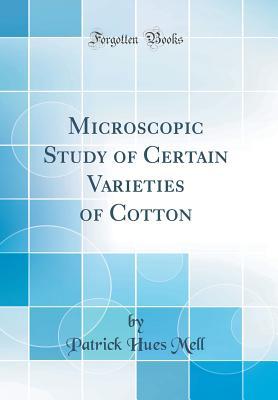Read Microscopic Study of Certain Varieties of Cotton (Classic Reprint) - Patrick Hues Mell Jr. file in PDF
Related searches:
2788 2046 3055 2701 2169 3482 1031 2920 2675 4181 911 1180 4154 358 4705
No matter your child's skill level, your own budget or their level of enthusiasm for biology and exploration, there is a perfect microscope waiting to engage them.
The microscope is a device used to view very small objects by magnifying the image. The microscope is a device used to view very small objects by magnifying the image.
A further study would involve a microscopic focus on the tissue cells, such as using stains to determine different types of dementia and other degenerative diseases, including chronic traumatic.
These are photomicrographs - very thin slices of rock, seen in plane-polarised light, or between crossed polarisers, when the colours seen are produced by interference of light.
Upfront marco under the microscope our car experts choose every product we feature.
Forensic epidemiologists may be assigned to investigate dangerous bacteria like salmonella. To carry out this task effectively, they make use of the microscope to study food for contamination. With the aid of the microscope, the presence of certain strains of bacteria will point out source of the contamination.
Microscopic and macroscopic are antonyms; the word microscopic describes something that is so small that it can only be seen with the aid of a microscope, while macroscopic refers either to something that can be seen with the naked.
Learn more about the evolution of microscopes with this detailed timeline that covers the history of microscopes. Thomas tolstrup / iconica / getty images a microscope is an instrument used for viewing objects that are too small to be seen.
Buzzfeed staff keep up with the latest daily buzz with the buzzfeed daily newsletter!.
A method was presented to fabricate epoxy resin crowns to be worn by human subjects requiring full crown restorations. These crowns were utilized in six young adults to study the internal structure of plaque after plaque formation periods of 1 and 3 days, 1 and 3 weeks and 2 months.
Histology is the the field of study that involves the microscopic examination of tissue appearance, organization, and function. Tissues are organized into four broad categories based on structural and functional similarities. These categories are epithelial, connective, muscle, and nervous.
A new study finds that some strains of this social amoeba, called dictyostelium discoideum, pack bacteria snacks with them before they travel.
If you were to look at some bones on a skeleton, you'd see a greyish rigid mass with some bumps histology is the science of the microscopic structure of cells, tissues and organs.
Covers brightfield microscopy, fluorescence microscopy, and electron microscopy.
The minerals present can exist in asbestiform, fibrous, prismatic, or massive varieties all at the same time.
Laboratory studies the light microscope, so called because it employs visible light to detect small objects, is probably the most spectacular views of nature and can enable students to perform some reasonably sophisticated experim.
A scanning electron microscopic study of platelets of certain animal species. Comparative morphology of platelets of the dog, cat, cow, horse, sheep, and goat was studied with the scanning electron microscope and was found generally similar. Most of the platelets were slightly biconvex of flat with relatively smooth surface and even contour.
When viewing different types of hair, you can also be able to differentiate them by certain characteristics, for example, the thickness between different strands. [in this figure] human hair under a stereo microscope at 5x magnification.
Microscopes help the scientists to study the microorganisms, the cells, the crystalline structures, and the molecular structures, they are one of the most important diagnostic tools when the doctors examine the tissue samples.
Apr 29, 2017 several types of animals come in microscopic varieties, including: microscopic algae were once thought to be plants, but recent studies have.
— the presence of microscopic hematuria — blood found in urine that can’t be seen by the naked eye — does not necessarily indicate the presence of cancer, according to a kaiser permanente southern california study published in the journal mayo clinic proceedings. The study suggests that tests routinely done on patients with this condition could be avoided and has led to the creation of a screening tool to better diagnose certain types of cancers.

Post Your Comments: